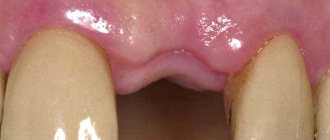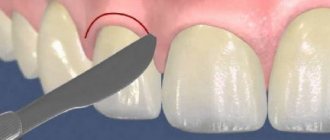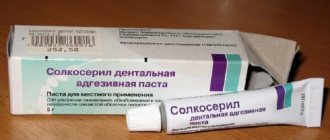Fear or apprehension before tooth extraction surgery is normal if it does not turn into panic and does not provoke a person into dangerous long-term inaction. When a patient in a dental surgeon’s office finally gets rid of a bad tooth, at that moment it may seem that all fears and problems are already behind them... However, in practice this does not always happen, and you need to be prepared for this.
After tooth extraction, many people begin to worry about another question - how long does it take for the hole and injured gum to heal? This is due to the fact that sometimes after the procedure the gums begin to be very bothersome, often bleeding of the socket and pain last for several days.
A wound in the mouth at the site of an extracted tooth generally creates a lot of inconvenience:
- sometimes the hole bleeds for a very long time, and a person in such a situation does not understand how to stop the incessant bleeding;
- the usual food tends to get into the hole, further injuring it;
- sometimes the wound begins to fester, and a putrid smell appears from it.
In order to understand how long it takes for gums to heal after tooth extraction, it is useful to first understand what processes occur in the tooth socket after surgery, how the process of “tightening” occurs, what factors contribute to this, and what seriously interfere with it, creating risks of re-infection tissues surrounding the wound with the development of complications - alveolitis (inflammation of the socket).
Immediately after the tooth is removed and the hole is filled with a blood clot, its healing mechanisms are launched, however, it is quite problematic to predict exactly how long the gums will heal, since this process is largely individual in nature and is influenced by a number of factors. However, having the necessary information, you can not only speed up the restoration of the gums and bone in the socket of the extracted tooth, but also make the healing stage relatively comfortable and quick.
Let's talk about all this in more detail.
Why does the socket (gums) sometimes take a long time to heal, and what does it depend on?
After the dental surgeon has removed the tooth from the socket, the wound healing process begins by so-called secondary intention. This means that the circular ligament around the tooth contracts and the edges of the gums move closer together. The formation of a blood clot in the socket has a very beneficial effect on the wound healing process after tooth extraction - this clot plays an important role as a kind of protection against possible infection. Accordingly, in no case should this clot be removed, for example, by intensive rinsing of the mouth or, especially, mechanically - with a finger or a toothpick.
The blood clot is replaced by granulation tissue within a few days, and then osteoid tissue is formed. In other words, over time, a new bone with gum formed above it forms in place of the removed tooth.
In case of traumatic tooth extraction, when the gums rupture and a significant part of the walls of the socket is damaged, the healing process can be very prolonged, and how long it takes for tissue restoration will depend on a number of factors.
The first of these factors is the condition of the wound immediately after the procedure: the more mistakes the doctor made, the worse the gums always heal.
Review
Two weeks ago I removed the roots of the last lower right tooth, a seven I think. At first, the removal went well: they made two injections into the gums: outside and inside, then the surgeon began to grab my painful tooth with forceps, but it broke off, and its pieces flew off onto my tongue.
After I spat, some nonsense began: the doctor took a chisel and a hammer and began to chisel along with the nurse on my tooth, as I understood - to divide the roots in half. It didn’t hurt, but it was terribly creepy, there were blows in my head, and the vibration created an unpleasant sensation. As soon as the roots crunched, the surgeon began to remove them with some sharp metal rods. It didn’t hurt, but a lot of blood came out because they were picking at the gum for about 30 minutes.
After extracting two roots in turn, the doctor put a piece of gauze in my mouth, let me squeeze it for 20 minutes and sent me home. When I came home, in the mirror I saw in the place of my former tooth a loose gum, both inside and outside, and my tongue was touching the edge of the bone, which was not covered by anything. Within an hour, the gums became very sore and began to bleed.
The laceration continued to hurt for more than 3 days, and even when it went away, the sharp edge of the bone still greatly interfered with my chewing. As a result, the hole at the site of the extracted tooth took a month and a half to heal, so I had to constantly rinse out any remaining food from it. I will never go to such a doctor again.
Ivan, Armavir
The second factor that determines the wound healing time is the possible addition of infection.
Infection of the socket often occurs during a complex extraction, when the carious remains of the diseased tooth are thrown deep into the wound, which causes it to fester. In most cases, after such a tooth extraction, the gums and socket take a very long time to heal.
However, it is important to note the fact that a purulent process in the hole can also occur as a result of poor wound care on the part of the patient himself: in this case, the infection occurs not during the removal procedure, but after it. When food constantly gets into the hole and accumulates there for a long time along with bacteria from the oral cavity, the wound can fester and its healing is significantly delayed.
It is also useful to read: Interesting details of wisdom teeth removal in the upper jaw
Stages of wound healing
The duration of the recovery period is due to the fact that after extraction, complex rehabilitation processes must occur in the gum, affecting not only soft tissues, but also the bone structures of the jaw.
Gum fusion
Immediately after extraction, the gums begin to heal - instead of the tooth that the doctor removed, a blood clot forms. It hermetically fills the empty hole, preventing infection from entering the wound or bleeding from developing. The clot contains white blood cells - T- and B-lymphocytes, neutrophilic leukocytes, immune proteins (antibodies and interferon). They complement the barrier function of the gum mucosa and do not allow bacteria to multiply.
Up to 3-4 days, the patient can see a wound with smooth edges, inside of which there is a dark gray-brown substance - a blood clot. You cannot remove a blood clot from a wound, so as not to cause bleeding or the development of alveolitis (inflammation of the gums at the site of tooth extraction).
On the 3-4th day, white films may appear on the surface of the gums - this is considered a good sign, because it means that the gums have begun to heal. Films should not be removed under any circumstances.
The gums heal completely in about 2-3 weeks. Outwardly, this manifests itself as the absence of a wound in the gum, its pale pink color, no different from the surrounding mucous membrane, and painlessness in the area of the extracted tooth. But sometimes the timing of regeneration may shift:
- Most often, wisdom teeth have many roots , which are strongly curved and difficult to remove from the alveoli. If the removal was long, the period of primary healing may shift by 4-5 days and amount to about 25 days.
- Infection and the development of inflammation in the wound can extend the rehabilitation period by another 1-1.5 weeks. The reason for this may be the absence of a blood clot or the patient’s attempts to remove it from the wound at home.
- Bone density in the area of the extracted tooth . Wisdom teeth wounds in the upper jaw heal faster because the strong outer layer of bone is thinner. Thanks to this, the removal of a wisdom tooth in the upper jaw is usually less traumatic, and the size of the wound is not as extensive as in the lower jaw.
Upon completion of this stage, the patient can begin preparing for prosthetics, since the gums have healed and are able to withstand the chewing load. But the bone tissue that will replace the cavity from the extracted tooth has not yet formed.
Formation of primary bone (callus)
After the gums heal, the hole begins to fill with coarse-fiber (unformed) bone tissue. This process takes 1.5-2 months, and as a result, a bone is formed with an irregular arrangement of hard bone cells in it.
It replaces the scar tissue that previously formed deep in the gums and serves as a framework for the formation of mature bone with an ordered structure of the beams.
Formation of secondary (mature) bone tissue
Gradually, the callus is replaced by mature tissue, in which the beams occupy an ordered position, the same as the bone of the sockets of neighboring teeth. The trabeculae of the mandibular bone are usually placed obliquely or horizontally, or in the form of loops, and have medium-sized cells with spongy substance.
In the bone of the upper jaw, the cells are small, mostly located vertically. This stage lasts up to 4 months from the moment of extraction.
Fusion of the gum with the periosteum
The gum at the extraction site is immovably fused with the periosteum of the jaws. Attachment of the gums to the regenerated bone begins no earlier than 4 months after tooth extraction. However, gums may take longer to heal: if complications develop, this stage may be delayed for a period of six months to 10 months.
Secondary infections or What interferes with healing?
It is believed that the oral cavity is the “dirtiest” place in the human body: here, in addition to the pathogenic microbes themselves, there is also a huge number of so-called conditionally pathogenic microorganisms. The word “conditionally” means that such microbes begin to cause harm only under certain conditions.
When a deep wound appears in the mouth after tooth extraction, which, moreover, is a kind of reservoir for food “waste,” microbes that previously could not harm a person turn from conditionally pathogenic to pathogenic, causing an inflammatory process with purulent phenomena. How long it will take the gums to heal after tooth extraction is, in this case, largely determined by the level of oral hygiene and proper wound care.
It is important to understand that a fresh wound in the mouth is generally vulnerable to any infections from the outside: for example, a secondary infection can occur with dirty hands while eating, with an old toothbrush and under many other circumstances. The restoration of infected socket tissues after tooth extraction slows down: almost always in such cases, the healing time of the gums extends for months, until the wound is independently cleared of necrotic formations and the growth of granulation tissue begins with the further formation of normal young bone.
How traumatic is the tooth extraction procedure?
Every person at least once in his life has encountered problems with tooth extraction. Like any other operation, removing a hard organ from the gum is considered a serious intervention in the human body. The soft tissues from which the tooth was extracted undergo some changes:
- the integrity of periodontal and periodontal tissue is compromised;
- the ligaments and muscles holding the tooth in the socket are torn;
- nerve bundles and blood vessels are damaged;
- all signs of the inflammatory process in the postoperative area are observed: hyperemia, cyanosis, pain, bleeding.
When the coronal part is small or completely absent, the dental surgeon has to use forceps to grab the tooth by the cervical area or exposed root, thereby injuring healthy periodontal tissue. Such manipulation additionally injures periodontal tissues, which leads to an increase in the rehabilitation period and increased pain in the mouth.
The area of gum injury depends on the dental disease itself for which the operation is performed, as well as on the skills of the surgeon.
To ensure that the patient feels comfortable during surgery and the doctor’s work proceeds without interruption, anesthesia is administered before tooth extraction.
What is the normal rate of healing, and what deviations may there be?
Complete approximation of the wound edges with a high-quality tooth extraction normally occurs in 2-2.5 weeks. Simultaneously with epithelization, the formation of bone beams and the development of young bone occur.
When a tooth is traumatically pulled out (with crushing and rupture of surrounding tissues), healing of the gums takes a long time, since after removal there remains a lacerated wound, the edges of which are often far from each other, and sections of the alveolus (bone) and the interradicular septum gape, not covered by the gingival edge. When tissue inflammation occurs in the hole and around it, the edges of the wound do not come together for a long time and epithelization is completed not after 2 weeks, but can take 30-50 days.
Only after 4-5 months is the formation of young bone tissue completed, and the final version of the gum “cover” is formed over the socket.
What can be dangerous about prolonged gum healing after tooth extraction?
As a result of infection joining the wound, alveolitis may occur - inflammation of the hole after tooth extraction, which usually develops already 1-3 days after the procedure. In this case, acute pain occurs in the area of the extracted tooth, normal healing of the socket is disrupted (an unpleasant putrid odor from the mouth is often also observed).
The result of the purulent inflammatory process is long-term healing of the gums, which, moreover, determines the risk of developing a serious complication - limited osteomyelitis of the jaw.
Of particular danger is prolonged healing of the gums due to the addition of infection after the removal of the lower wisdom tooth. Since the lower wisdom teeth are surrounded by soft tissues that have an abundant blood supply, the entry of bacteria into the wound after a simple or, even more so, complex removal can lead to serious consequences, including the spread of infection deep into the tissue. Infection of the jaw and peri-maxillary areas against the background of reduced immunity can lead to life-threatening abscesses and phlegmon.
The extreme expression of these complications is sepsis - infection of the blood with pathogenic microbial flora, which may well lead to death.
Associated symptoms and what they indicate
Tooth extraction is a surgical procedure that involves tissue dissection. The operation itself is not complicated, but the anatomical features of the patient and his state of health make adjustments to the recovery process. It is recommended to monitor the situation based on symptoms.
| Symptoms during healing of the hole | |
| Name | What do they point to? |
| White hole | 1-2 days after the operation, the hole becomes covered with a white coating; this is a physiological process that does not cause concern. If a white spot forms at elevated temperature and pain, then alveolitis is often diagnosed based on a combination of symptoms. |
| Gums hurt | Non-increasing gum pain for 7-10 days is considered normal. If the pain intensifies every day and does not go away after the specified period, then it is likely that the infection is progressing in the body. |
| The gums are swollen | Swelling after surgery goes away within 3 days. The fourth day is a control day. If the swelling subsides, there is no cause for concern; in other cases, immediate assistance from a specialist is required. |
| Swollen cheek | If after surgery the swelling is small and there are no signs of its increase, then this is normal. If there is severe swelling that does not go away after 2-3 days, you should consult a doctor. The symptom may indicate the onset of inflammation or infection. |
| There's blood coming | The presence of blood after surgery should not be a concern. Discharge from the hole for up to half an hour is normal. Sometimes, due to the characteristics of the body, this period extends to two hours. If the bleeding does not stop, then the reasons may be the following: damage to blood vessels during manipulation, the onset of an inflammatory process, poor blood clotting, the effect of blood thinning drugs. |
| The temperature has risen | If after tooth extraction there is an increase in temperature to 37.5° on the first day, there is no need to be afraid. With further deterioration of health, this symptom indicates infection of the wound. |
We invite you to read Recommendations after tooth extraction
Diseases that pose risks during and after removal
For normal gum healing in the future, diseases that a person may have at the time of tooth extraction play an important role. For example, with long-term use of blood thinners, diabetes mellitus, or blood diseases that are accompanied by poor blood clotting, bleeding from the socket may occur and does not go away for a long time after the procedure. Sometimes the bleeding may not stop for more than a day.
For normal healing of the gums, it is necessary to stop the blood as early as possible in order to form a clot, which plays an important protective role for a fresh wound. After a tooth has been pulled out, it is the presence of a blood clot in the socket that makes it possible to most effectively stimulate the restoration of damaged tissue.
From the practice of a dentist
A couple of years ago, patient I., 62 years old, came to me about the removal of the lower central incisor, which had high mobility. After simple removal for 1-2 minutes, I carried out a classic stop of bleeding by pressing a gauze swab against the hole and gave recommendations.
The next day, the patient contacted me again, this time about the bleeding from the hole that did not stop. It turned out that he hid from me the fact that he was taking indirect anticoagulants, that is, drugs that “thin” the blood, so stopping the bleeding at home did not bring any results.
After filling the hole with hemostatic agents and temporarily stopping these drugs by a cardiologist, the problem was solved.
Dentist-surgeon Ivan Sergeevich, Anapa
How to speed up the gum healing process after tooth extraction
To understand how you can effectively accelerate gum healing after tooth extraction, you should remember the conditions for normal healing of living tissue in general.
It is also useful to read: How to stop bleeding after tooth extraction
The most favorable option for wound healing is to create the most sterile conditions possible. Naturally, the concept of “sterile” is only very conditional here, since the destruction of all bacteria (both beneficial and harmful) can lead to negative consequences, for example, dysbiosis in the oral cavity, which affects the general health of a person. In order not to cause harm to health, but to ensure comfortable and short healing for the hole after tooth extraction, both general and local methods can be used to prevent secondary infection.
There are certain rules, the implementation of which will allow the gums to begin to recover successfully within the next few hours after the tooth extraction procedure:
- Hold tightly with your teeth the gauze swab placed by the doctor on the hole after removal. It is the pressure on the edges of the wound that is important, and not the time, although the average holding period is regulated and is 15-20 minutes.
- You should not eat food for 3 hours, and it is advisable not to drink, so as not to disrupt the process of formation of a blood clot in the socket.
- You should not smoke or drink alcoholic beverages, spicy, hot or solid foods in the first days after removal. Following this simple rule will protect the “blood plug” from injury, and the socket from repeated bleeding and purulent inflammation.
- You cannot engage in heavy physical labor, sports, go to the bathhouse, sauna, sunbathe and overheat for several days (for the same reasons).
- If possible, avoid chewing or sleeping on the same side of the jaw where the tooth was removed for two days.
To speed up the healing process of the gums after tooth extraction, you can also use local methods of caring for the hole. The most popular among the options used are rinses, although a number of doctors warn about possible harm to the blood clot. The fact is that some patients mistakenly start rinsing with anything: soda, salt, vodka, vinegar, hydrogen peroxide, etc. Who is much more than that.
Sometimes such methods do not cause harm only by luck, but most often the wound is irritated and the blood clot is destroyed, which not only does not speed up the gum healing process, but also significantly lengthens it, bringing additional pain and suffering to the adherent of such folk methods. It also happens that such mockery of one’s own health leads a person straight to the operating table.
Generally speaking, even rinses with infusions, herbal decoctions and pharmaceutical solutions approved by most dentists cause a lot of controversy regarding the start of rinsing, frequency and duration. Dental surgeons have their own opinion on this matter, since if you prescribe rinsing from the first day of tooth extraction (mainly after eating), this will prevent the accumulation of food debris in the wound and its rotting, but can lead to the separation of a blood clot during intensive “ gurgling" in the mouth of a decoction of the same chamomile or sage.
Based on the position of common sense, you can use herbal decoctions (chamomile, sage), pharmaceuticals (a weak solution of furatsilin and chlorhexidine), after consulting with a doctor, and use them only after meals, very carefully and without fanaticism, especially in the first two days after tooth extraction, so that the healing of the hole is comfortable.
Dentist's opinion
My position regarding home rinsing with solutions after tooth extraction to speed up gum healing is simple and understandable to everyone, as it has logic and scientific justification. On the first day after removal, you should not use rinses, but limit yourself to oral baths. That is, it is not recommended to rinse your mouth, but rather hold the antiseptic in your mouth and spit, and repeat this for 2-3 minutes, at least 6-8 times a day.
In my practice, I do not prescribe furatsilin, because, firstly, it still needs to be diluted to the required concentration so as not to cause irritation in the oral cavity, and, secondly, it dries out the mucous membrane greatly.
Decoctions of chamomile and sage are excellent for mouth baths on the first day of tooth extraction, and subsequently for rinsing after each meal. However, this is an excellent budget option, and modern means for preventing socket suppuration are antibacterial drugs, ointments, and gels for topical use.
Dental surgeon, Oleg, Moscow
For topical use in order to accelerate gum healing after tooth extraction, a dental surgeon may prescribe Solcoseryl dental adhesive paste, Metrogyl Denta gel or other drugs.
In case of difficult removal of a wisdom tooth, in case of tooth extraction due to serious purulent odontogenic processes in the surrounding tissues and jaw bone, as well as in weakened patients, additional antibacterial therapy is prescribed, most often with antibiotic drugs, as they reduce the microbial load in and around the wound , as a result of which the gums take less time to heal.











